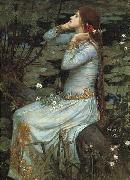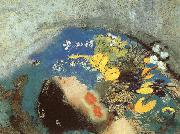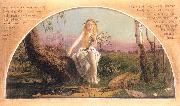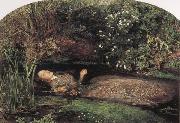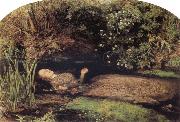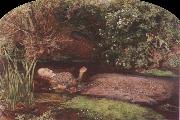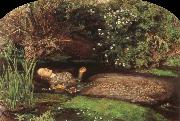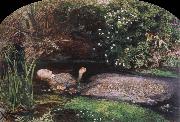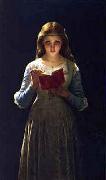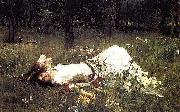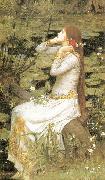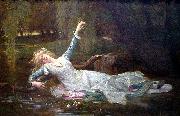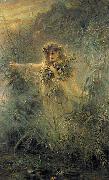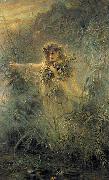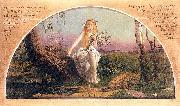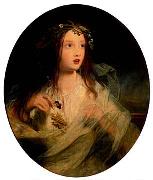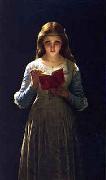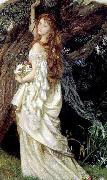Wholesale Oil Painting No Minimum |
|||||||||||
|
|
|||||||||||

|
|||||||||||
|
|
|
||||||||
John William WaterhouseEnglish Pre-Raphaelite Painter, 1849-1917 English painter. His father was a minor English painter working in Rome. Waterhouse entered the Royal Academy Schools in London in 1870. He exhibited at the Society of British Artists from 1872 and at the Royal Academy from 1874. From 1877 to the 1880s he regularly travelled abroad, particularly to Italy. In the early 1870s he had produced a few uncharacteristic Orientalist keepsake paintings, but most of his works in this period are scenes from ancient history or classical genre subjects, similar to the work of Lawrence Alma-Tadema (e.g. Consulting the Oracle, c. 1882; London, Tate). However, Waterhouse consistently painted on a larger scale than Alma-Tadema. His brushwork is bolder, his sunlight casts harsher shadows and his history paintings are more dramatic. |
||||||||
|
|
||||||||
Ophelia
Ophelia Painting ID:: 448 |
1894
Private collection 1894 Private collection |
|||||||
|
|
||||||||
Odilon RedonFrench Symbolist Painter, 1840-1916 Bertrand-Jean Redon, better known as Odilon Redon (April 20, 1840 ?C July 6, 1916) was a Symbolist painter and printmaker, born in Bordeaux, Aquitaine, France. Odilon was a nickname derived from his mother, Odile. Redon started drawing as a young child, and at the age of 10 he was awarded a drawing prize at school. At age 15, he began formal study in drawing but on the insistence of his father he switched to architecture. His failure to pass the entrance exams at Paris?? Ecole des Beaux-Arts ended any plans for a career as an architect, although he would later study there under Jean-L??on Gerôme. Back home in his native Bordeaux, he took up sculpture, and Rodolphe Bresdin instructed him in etching and lithography. However, his artistic career was interrupted in 1870 when he joined the army to serve in the Franco-Prussian War. At the end of the war, he moved to Paris, working almost exclusively in charcoal and lithography. It would not be until 1878 that his work gained any recognition with Guardian Spirit of the Waters, and he published his first album of lithographs, titled Dans le R??ve, in 1879. Still, Redon remained relatively unknown until the appearance in 1884 of a cult novel by Joris-Karl Huysmans titled, À rebours (Against Nature). The story featured a decadent aristocrat who collected Redon's drawings. In the 1890s, he began to use pastel and oils, which dominated his works for the rest of his life. In 1899, he exhibited with the Nabis at Durand-Ruel's. In 1903 he was awarded the Legion of Honor. His popularity increased when a catalogue of etchings and lithographs was published by Andr?? Mellerio in 1913 and that same year, he was given the largest single representation at the New York Armory Show. In 1923 Mellerio published: Odilon Redon: Peintre Dessinateur et Graveur. An archive of Mellerio's papers is held by the Ryerson & Burnham Libraries at the Art Institute of Chicago. In 2005 the Museum of Modern Art launched an exhibition entitled "Beyond The Visible", a comprehensive overview of Redon's work showcasing more than 100 paintings, drawings, prints and books from The Ian Woodner Family Collection. The exhibition ran from October 30, 2005 to January 23, 2006. |
||||||||
|
|
||||||||
|
|
Ophelia
Ophelia Painting ID:: 3345 |
1900/1905
The Ian Woodner Family Collection, New York 1900/1905 The Ian Woodner Family Collection, New York |
||||||
|
|
||||||||
Arthur Devis1712-1787 English By 1728 he had left Preston, and the following year he was working in London for the Flemish topographical and sporting painter Peter Tillemans. There he specialized in landscape painting and copying various works in Tillemans studio after Marco Ricci, Giovanni Paolo Panini and Jan van Bloemen. Devis earliest known commission, Hoghton Towers from Duxon Hill, Lancashire (1735; priv. col., see 1983 exh. cat., no. 3), painted for Sir Henry Hoghton during a trip to Preston in 1734-5, shows Tillemans influence in its attention to detail and the use of thin, transparent paint. Thomas Lister with his Family (c. 1738; Chicago, IL, A. Inst.) demonstrates a similar interest in landscape, featuring the family group in Gisburn Park, Lancs. Devis had returned to London by 1742 and established himself as a painter of conversation pieces, with a studio in Great Queen Street. Roger Hesketh with his Family is typical of his work at this time; it shows how Devis transformed the intimacy of a Dutch 17th-century genre scene into an elegant interior with the group of sitters connected by formal, schematic gestures. Roger Hesketh stands apart, in a tastefully contrived pose, his legs crossed and right arm thrust inside his waistcoat. His son, Fleetwood, stands with his hand resting on a dog next to his wife, who is seated with an infant on her lap. The adjacent telescope, globe and marine paintings are intended to advertise Hesketh interest in astronomy and travel. |
||||||||
|
|
||||||||
|
|
Ophelia
Ophelia Painting ID:: 19092 |
1852, retouched 1857-58
Oil on panel. 1852, retouched 1857-58 Oil on panel. |
||||||
|
|
||||||||
Sir John Everett MillaisBritish 1829-1896 Sir John Everett Millais Galleries After his marriage, Millais began to paint in a broader style, which was condemned by Ruskin as "a catastrophe". It has been argued that this change of style resulted from Millais' need to increase his output to support his growing family. Unsympathetic critics such as William Morris accused him of "selling out" to achieve popularity and wealth. His admirers, in contrast, pointed to the artist's connections with Whistler and Albert Moore, and influence on John Singer Sargent. Millais himself argued that as he grew more confident as an artist, he could paint with greater boldness. In his article "Thoughts on our art of Today" (1888) he recommended Vel??zquez and Rembrandt as models for artists to follow. The Two Princes Edward and Richard in the Tower (1878) The Boyhood of Raleigh (1871)Paintings such as The Eve of St. Agnes and The Somnambulist clearly show an ongoing dialogue between the artist and Whistler, whose work Millais strongly supported. Other paintings of the late 1850s and 1860s can be interpreted as anticipating aspects of the Aesthetic Movement. Many deploy broad blocks of harmoniously arranged colour and are symbolic rather than narratival. Later works, from the 1870s onwards demonstrate Millais' reverence for old masters such as Joshua Reynolds and Vel??zquez. Many of these paintings were of an historical theme and were further examples of Millais' talent. Notable among these are The Two Princes Edward and Richard in the Tower (1878) depicting the Princes in the Tower, The Northwest Passage (1874) and the Boyhood of Raleigh (1871). Such paintings indicate Millais' interest in subjects connected to Britain's history and expanding empire. His last project was to be a painting depicting a white hunter lying dead in the African veldt, his body contemplated by two indifferent Africans. This fascination with wild and bleak locations is also evident in his many landscape paintings of this period, which usually depict difficult or dangerous terrain. The first of these, Chill October (1870) was painted in Perth, near his wife's family home. Many others were painted elsewhere in Perthshire, near Dunkeld and Birnam, where Millais rented grand houses each autumn in order to hunt and fish. Millais also achieved great popularity with his paintings of children, notably Bubbles (1886) ?C famous, or perhaps notorious, for being used in the advertising of Pears soap ?C and Cherry Ripe. |
||||||||
|
|
||||||||
|
|
Ophelia
Ophelia Painting ID:: 27673 |
mk58
1851-2
oil on canvas
76.2x111.8cm
Tate.London
mk58 1851-2 oil on canvas 76.2x111.8cm Tate.London |
||||||
|
|
||||||||
Sir John Everett MillaisBritish 1829-1896 Sir John Everett Millais Galleries After his marriage, Millais began to paint in a broader style, which was condemned by Ruskin as "a catastrophe". It has been argued that this change of style resulted from Millais' need to increase his output to support his growing family. Unsympathetic critics such as William Morris accused him of "selling out" to achieve popularity and wealth. His admirers, in contrast, pointed to the artist's connections with Whistler and Albert Moore, and influence on John Singer Sargent. Millais himself argued that as he grew more confident as an artist, he could paint with greater boldness. In his article "Thoughts on our art of Today" (1888) he recommended Vel??zquez and Rembrandt as models for artists to follow. The Two Princes Edward and Richard in the Tower (1878) The Boyhood of Raleigh (1871)Paintings such as The Eve of St. Agnes and The Somnambulist clearly show an ongoing dialogue between the artist and Whistler, whose work Millais strongly supported. Other paintings of the late 1850s and 1860s can be interpreted as anticipating aspects of the Aesthetic Movement. Many deploy broad blocks of harmoniously arranged colour and are symbolic rather than narratival. Later works, from the 1870s onwards demonstrate Millais' reverence for old masters such as Joshua Reynolds and Vel??zquez. Many of these paintings were of an historical theme and were further examples of Millais' talent. Notable among these are The Two Princes Edward and Richard in the Tower (1878) depicting the Princes in the Tower, The Northwest Passage (1874) and the Boyhood of Raleigh (1871). Such paintings indicate Millais' interest in subjects connected to Britain's history and expanding empire. His last project was to be a painting depicting a white hunter lying dead in the African veldt, his body contemplated by two indifferent Africans. This fascination with wild and bleak locations is also evident in his many landscape paintings of this period, which usually depict difficult or dangerous terrain. The first of these, Chill October (1870) was painted in Perth, near his wife's family home. Many others were painted elsewhere in Perthshire, near Dunkeld and Birnam, where Millais rented grand houses each autumn in order to hunt and fish. Millais also achieved great popularity with his paintings of children, notably Bubbles (1886) ?C famous, or perhaps notorious, for being used in the advertising of Pears soap ?C and Cherry Ripe. |
||||||||
|
|
||||||||
|
|
Ophelia
Ophelia Painting ID:: 34011 |
mk87
1851
Oil on canvas
76x112cm
London,Tate Gallery
mk87 1851 Oil on canvas 76x112cm London,Tate Gallery |
||||||
|
|
||||||||
Sir John Everett MillaisBritish 1829-1896 Sir John Everett Millais Galleries After his marriage, Millais began to paint in a broader style, which was condemned by Ruskin as "a catastrophe". It has been argued that this change of style resulted from Millais' need to increase his output to support his growing family. Unsympathetic critics such as William Morris accused him of "selling out" to achieve popularity and wealth. His admirers, in contrast, pointed to the artist's connections with Whistler and Albert Moore, and influence on John Singer Sargent. Millais himself argued that as he grew more confident as an artist, he could paint with greater boldness. In his article "Thoughts on our art of Today" (1888) he recommended Vel??zquez and Rembrandt as models for artists to follow. The Two Princes Edward and Richard in the Tower (1878) The Boyhood of Raleigh (1871)Paintings such as The Eve of St. Agnes and The Somnambulist clearly show an ongoing dialogue between the artist and Whistler, whose work Millais strongly supported. Other paintings of the late 1850s and 1860s can be interpreted as anticipating aspects of the Aesthetic Movement. Many deploy broad blocks of harmoniously arranged colour and are symbolic rather than narratival. Later works, from the 1870s onwards demonstrate Millais' reverence for old masters such as Joshua Reynolds and Vel??zquez. Many of these paintings were of an historical theme and were further examples of Millais' talent. Notable among these are The Two Princes Edward and Richard in the Tower (1878) depicting the Princes in the Tower, The Northwest Passage (1874) and the Boyhood of Raleigh (1871). Such paintings indicate Millais' interest in subjects connected to Britain's history and expanding empire. His last project was to be a painting depicting a white hunter lying dead in the African veldt, his body contemplated by two indifferent Africans. This fascination with wild and bleak locations is also evident in his many landscape paintings of this period, which usually depict difficult or dangerous terrain. The first of these, Chill October (1870) was painted in Perth, near his wife's family home. Many others were painted elsewhere in Perthshire, near Dunkeld and Birnam, where Millais rented grand houses each autumn in order to hunt and fish. Millais also achieved great popularity with his paintings of children, notably Bubbles (1886) ?C famous, or perhaps notorious, for being used in the advertising of Pears soap ?C and Cherry Ripe. |
||||||||
|
|
||||||||
|
|
Ophelia
Ophelia Painting ID:: 40708 |
mk156
1851
Oil on canvas
76x112cm
mk156 1851 Oil on canvas 76x112cm |
||||||
|
|
||||||||
Sir John Everett MillaisBritish 1829-1896 Sir John Everett Millais Galleries After his marriage, Millais began to paint in a broader style, which was condemned by Ruskin as "a catastrophe". It has been argued that this change of style resulted from Millais' need to increase his output to support his growing family. Unsympathetic critics such as William Morris accused him of "selling out" to achieve popularity and wealth. His admirers, in contrast, pointed to the artist's connections with Whistler and Albert Moore, and influence on John Singer Sargent. Millais himself argued that as he grew more confident as an artist, he could paint with greater boldness. In his article "Thoughts on our art of Today" (1888) he recommended Vel??zquez and Rembrandt as models for artists to follow. The Two Princes Edward and Richard in the Tower (1878) The Boyhood of Raleigh (1871)Paintings such as The Eve of St. Agnes and The Somnambulist clearly show an ongoing dialogue between the artist and Whistler, whose work Millais strongly supported. Other paintings of the late 1850s and 1860s can be interpreted as anticipating aspects of the Aesthetic Movement. Many deploy broad blocks of harmoniously arranged colour and are symbolic rather than narratival. Later works, from the 1870s onwards demonstrate Millais' reverence for old masters such as Joshua Reynolds and Vel??zquez. Many of these paintings were of an historical theme and were further examples of Millais' talent. Notable among these are The Two Princes Edward and Richard in the Tower (1878) depicting the Princes in the Tower, The Northwest Passage (1874) and the Boyhood of Raleigh (1871). Such paintings indicate Millais' interest in subjects connected to Britain's history and expanding empire. His last project was to be a painting depicting a white hunter lying dead in the African veldt, his body contemplated by two indifferent Africans. This fascination with wild and bleak locations is also evident in his many landscape paintings of this period, which usually depict difficult or dangerous terrain. The first of these, Chill October (1870) was painted in Perth, near his wife's family home. Many others were painted elsewhere in Perthshire, near Dunkeld and Birnam, where Millais rented grand houses each autumn in order to hunt and fish. Millais also achieved great popularity with his paintings of children, notably Bubbles (1886) ?C famous, or perhaps notorious, for being used in the advertising of Pears soap ?C and Cherry Ripe. |
||||||||
|
|
||||||||
|
|
Ophelia
Ophelia Painting ID:: 53424 |
mk231
1852
Oil on canvas
30x44in
mk231 1852 Oil on canvas 30x44in |
||||||
|
|
||||||||
Arthur Hughes1832-1915 British Arthur Hughes Gallery Hughes was born in London. His best-known paintings are April Love and The Long Engagement, both of which depict troubled couples contemplating the transience of love and beauty. They were inspired by John Everett Millais's earlier "couple" paintings but place far greater emphasis on the pathos of human inability to maintain the freshness of youthful feeling in comparison to the regenerative power of nature. Like Millais, Hughes also painted an Ophelia and illustrated Keats's poem The Eve of St. Agnes. Hughes's version of the latter is in the form of a secular triptych, a technique he repeated for scenes from Shakespeare's As You Like It. His works are noted for their magical, glowing colouring and delicate draughtsmanship. Hughes was in close contact with the writer George MacDonald and illustrated some of his books as well as producing numerous illustrations for Norman MacLeod's monthly magazine, Good Words. Hughes died in Kew Green, London, leaving about 700 known paintings and drawings, along with over 750 book illustrations. |
||||||||
|
|
||||||||
|
|
Ophelia
Ophelia Painting ID:: 53425 |
mk231
1852
Oil on canvas
68.6x123.8cm
mk231 1852 Oil on canvas 68.6x123.8cm |
||||||
|
|
||||||||
Sir John Everett MillaisBritish 1829-1896 Sir John Everett Millais Galleries After his marriage, Millais began to paint in a broader style, which was condemned by Ruskin as "a catastrophe". It has been argued that this change of style resulted from Millais' need to increase his output to support his growing family. Unsympathetic critics such as William Morris accused him of "selling out" to achieve popularity and wealth. His admirers, in contrast, pointed to the artist's connections with Whistler and Albert Moore, and influence on John Singer Sargent. Millais himself argued that as he grew more confident as an artist, he could paint with greater boldness. In his article "Thoughts on our art of Today" (1888) he recommended Vel??zquez and Rembrandt as models for artists to follow. The Two Princes Edward and Richard in the Tower (1878) The Boyhood of Raleigh (1871)Paintings such as The Eve of St. Agnes and The Somnambulist clearly show an ongoing dialogue between the artist and Whistler, whose work Millais strongly supported. Other paintings of the late 1850s and 1860s can be interpreted as anticipating aspects of the Aesthetic Movement. Many deploy broad blocks of harmoniously arranged colour and are symbolic rather than narratival. Later works, from the 1870s onwards demonstrate Millais' reverence for old masters such as Joshua Reynolds and Vel??zquez. Many of these paintings were of an historical theme and were further examples of Millais' talent. Notable among these are The Two Princes Edward and Richard in the Tower (1878) depicting the Princes in the Tower, The Northwest Passage (1874) and the Boyhood of Raleigh (1871). Such paintings indicate Millais' interest in subjects connected to Britain's history and expanding empire. His last project was to be a painting depicting a white hunter lying dead in the African veldt, his body contemplated by two indifferent Africans. This fascination with wild and bleak locations is also evident in his many landscape paintings of this period, which usually depict difficult or dangerous terrain. The first of these, Chill October (1870) was painted in Perth, near his wife's family home. Many others were painted elsewhere in Perthshire, near Dunkeld and Birnam, where Millais rented grand houses each autumn in order to hunt and fish. Millais also achieved great popularity with his paintings of children, notably Bubbles (1886) ?C famous, or perhaps notorious, for being used in the advertising of Pears soap ?C and Cherry Ripe. |
||||||||
|
|
||||||||
|
|
ophelia
ophelia Painting ID:: 56233 |
mk247
1851 to 52,oil on canvas,30x44 in,76x112 cm,tate collection,london,uk mk247 1851 to 52,oil on canvas,30x44 in,76x112 cm,tate collection,london,uk |
||||||
|
|
||||||||
Pierre Auguste Cot(February 17, 1837 ?C 1883) was a French painter of the Academic Classicism school. He was born in B??darieux, and initially studied at l'Ecole des Beaux-Arts in Toulouse before going to Paris. He studied under Leon Cogniet, Alexandre Cabanel and William-Adolphe Bouguereau. From the 1870s, his popularity grew quickly. In 1874 he was made Chevalier of the Legion of Honour. He created several works of lasting popularity, including Le Printemps, featuring two young lovers sitting upon a swing, and The Storm. Both these paintings are on display at the Metropolitan Museum of Art in New York City; |
||||||||
|
|
||||||||
|
|
Ophelia
Ophelia Painting ID:: 58467 |
Ophelia, 1870 Ophelia, 1870 |
||||||
|
|
||||||||
John William WaterhouseEnglish Pre-Raphaelite Painter, 1849-1917 English painter. His father was a minor English painter working in Rome. Waterhouse entered the Royal Academy Schools in London in 1870. He exhibited at the Society of British Artists from 1872 and at the Royal Academy from 1874. From 1877 to the 1880s he regularly travelled abroad, particularly to Italy. In the early 1870s he had produced a few uncharacteristic Orientalist keepsake paintings, but most of his works in this period are scenes from ancient history or classical genre subjects, similar to the work of Lawrence Alma-Tadema (e.g. Consulting the Oracle, c. 1882; London, Tate). However, Waterhouse consistently painted on a larger scale than Alma-Tadema. His brushwork is bolder, his sunlight casts harsher shadows and his history paintings are more dramatic. |
||||||||
|
|
||||||||
|
|
Ophelia
Ophelia Painting ID:: 61557 |
Ophelia
1889
Ophelia 1889 |
||||||
|
|
||||||||
John William WaterhouseEnglish Pre-Raphaelite Painter, 1849-1917 English painter. His father was a minor English painter working in Rome. Waterhouse entered the Royal Academy Schools in London in 1870. He exhibited at the Society of British Artists from 1872 and at the Royal Academy from 1874. From 1877 to the 1880s he regularly travelled abroad, particularly to Italy. In the early 1870s he had produced a few uncharacteristic Orientalist keepsake paintings, but most of his works in this period are scenes from ancient history or classical genre subjects, similar to the work of Lawrence Alma-Tadema (e.g. Consulting the Oracle, c. 1882; London, Tate). However, Waterhouse consistently painted on a larger scale than Alma-Tadema. His brushwork is bolder, his sunlight casts harsher shadows and his history paintings are more dramatic. |
||||||||
|
|
||||||||
|
|
Ophelia
Ophelia Painting ID:: 61565 |
Ophelia
1894
Ophelia 1894 |
||||||
|
|
||||||||
John William WaterhouseEnglish Pre-Raphaelite Painter, 1849-1917 English painter. His father was a minor English painter working in Rome. Waterhouse entered the Royal Academy Schools in London in 1870. He exhibited at the Society of British Artists from 1872 and at the Royal Academy from 1874. From 1877 to the 1880s he regularly travelled abroad, particularly to Italy. In the early 1870s he had produced a few uncharacteristic Orientalist keepsake paintings, but most of his works in this period are scenes from ancient history or classical genre subjects, similar to the work of Lawrence Alma-Tadema (e.g. Consulting the Oracle, c. 1882; London, Tate). However, Waterhouse consistently painted on a larger scale than Alma-Tadema. His brushwork is bolder, his sunlight casts harsher shadows and his history paintings are more dramatic. |
||||||||
|
|
||||||||
|
|
Ophelia
Ophelia Painting ID:: 61590 |
Ophelia
1910
Ophelia 1910 |
||||||
|
|
||||||||
Alexandre CabanelFrench Academic Painter, 1823-1889 French painter and teacher. His skill in drawing was apparently evident by the age of 11. His father could not afford his training, but in 1839 his departement gave him a grant to go to Paris. This enabled him to register at the Ecole des Beaux-Arts the following October as a pupil of Franeois-Edouard Picot. At his first Salon in 1843 he presented Agony in the Garden (Valenciennes, Mus. B.-A.) and won second place in the Prix de Rome competition (after Leon B?nouville, also a pupil of Picot) in 1845 with Christ at the Praetorium (Paris, Ecole N. Sup. B.-A.). Both Cabanel and Benouville were able to go to Rome, as there was a vacancy from the previous year. Cabanel's Death of Moses (untraced), an academic composition, painted to comply with the regulations of the Ecole de Rome, was exhibited at the Salon of 1852. |
||||||||
|
|
||||||||
|
|
Ophelia
Ophelia Painting ID:: 68629 |
Technique Oil on canvas
Dimensions 77 ?? 117.5 cm
Technique Oil on canvas Dimensions 77 ?? 117.5 cm |
||||||
|
|
||||||||
Alexandre CabanelFrench Academic Painter, 1823-1889 French painter and teacher. His skill in drawing was apparently evident by the age of 11. His father could not afford his training, but in 1839 his departement gave him a grant to go to Paris. This enabled him to register at the Ecole des Beaux-Arts the following October as a pupil of Franeois-Edouard Picot. At his first Salon in 1843 he presented Agony in the Garden (Valenciennes, Mus. B.-A.) and won second place in the Prix de Rome competition (after Leon B?nouville, also a pupil of Picot) in 1845 with Christ at the Praetorium (Paris, Ecole N. Sup. B.-A.). Both Cabanel and Benouville were able to go to Rome, as there was a vacancy from the previous year. Cabanel's Death of Moses (untraced), an academic composition, painted to comply with the regulations of the Ecole de Rome, was exhibited at the Salon of 1852. |
||||||||
|
|
||||||||
|
|
Ophelia
Ophelia Painting ID:: 71895 |
1883(1883)
Oil on canvas
77 x 117.5 cm (30.31 x 46.26 in)
1883(1883) Oil on canvas 77 x 117.5 cm (30.31 x 46.26 in) |
||||||
|
|
||||||||
Alexandre Cabanel1823-1889 French Alexandre Cabanel Locations French painter and teacher. His skill in drawing was apparently evident by the age of 11. His father could not afford his training, but in 1839 his departement gave him a grant to go to Paris. This enabled him to register at the Ecole des Beaux-Arts the following October as a pupil of Francois-Edouard Picot. At his first Salon in 1843 he presented Agony in the Garden (Valenciennes, Mus. B.-A.) and won second place in the Prix de Rome competition (after Lon Benouville, also a pupil of Picot) in 1845 with Christ at the Praetorium (Paris, Ecole N. Sup. B.-A.). Both Cabanel and Benouville were able to go to Rome, as there was a vacancy from the previous year. Cabanel Death of Moses (untraced), an academic composition, painted to comply with the regulations of the Ecole de Rome, was exhibited at the Salon of 1852. The pictures he painted for Alfred Bruyas, his chief patron at this time (and, like Cabanel, a native of Montpellier), showed more clearly the direction his art had taken during his stay in Italy. Albayde, Angel of the Evening, Chiarruccia and Velleda (all in Montpellier, Mus. Fabre) were the first of many mysterious or tragic heroines painted by Cabanel and show his taste for the elegiac types and suave finish of the Florentine Mannerists. |
||||||||
|
|
||||||||
|
|
Ophelia
Ophelia Painting ID:: 73176 |
Date 1883(1883)
Medium Oil on canvas
Dimensions 77 X 117.5 cm (30.31 X 46.26 in)
cyf Date 1883(1883) Medium Oil on canvas Dimensions 77 X 117.5 cm (30.31 X 46.26 in) cyf |
||||||
|
|
||||||||
Konstantin Makovsky1839 September 17 [O.S. September 30] 1915) was an influential Russian painter, affiliated with the "Peredvizhniki (Wanderers)". Many of his historical paintings, such as The Russian Bride's Attire (1889), showed an idealized view of Russian life of prior centuries. He is often considered a representative of a Salon art. Konstantin was born in Moscow as the older son of a Russian art figure and amateur painter, Yegor Ivanovich Makovsky. Yegor Makovsky was the founder of Natural class, the art school that later became as the famous Moscow School of Painting, Sculpture and Architecture. Among the friends of the family were Karl Briullov and Vasily Tropinin. All children of Yegor became notable painters (see Makovsky). Later Konstantin wrote For what I became I think I should thank not the Academy or Professors but only my father. In 1851 Konstantin entered the Moscow School of Painting, Sculpture and Architecture where he became the top student, easily getting all the available awards. |
||||||||
|
|
||||||||
|
|
Ophelia
Ophelia Painting ID:: 74284 |
Oil on canvas
221 X 136 cm (87.01 X 53.54 in)
cjr Oil on canvas 221 X 136 cm (87.01 X 53.54 in) cjr |
||||||
|
|
||||||||
Konstantin Makovsky1839 September 17 [O.S. September 30] 1915) was an influential Russian painter, affiliated with the "Peredvizhniki (Wanderers)". Many of his historical paintings, such as The Russian Bride's Attire (1889), showed an idealized view of Russian life of prior centuries. He is often considered a representative of a Salon art. Konstantin was born in Moscow as the older son of a Russian art figure and amateur painter, Yegor Ivanovich Makovsky. Yegor Makovsky was the founder of Natural class, the art school that later became as the famous Moscow School of Painting, Sculpture and Architecture. Among the friends of the family were Karl Briullov and Vasily Tropinin. All children of Yegor became notable painters (see Makovsky). Later Konstantin wrote For what I became I think I should thank not the Academy or Professors but only my father. In 1851 Konstantin entered the Moscow School of Painting, Sculpture and Architecture where he became the top student, easily getting all the available awards. |
||||||||
|
|
||||||||
|
|
Ophelia
Ophelia Painting ID:: 75690 |
Medium Oil on canvas
Dimensions 221 ?? 136 cm (87 ?? 53.5 in)
cyf Medium Oil on canvas Dimensions 221 ?? 136 cm (87 ?? 53.5 in) cyf |
||||||
|
|
||||||||
Arthur Hughes1832-1915 British Arthur Hughes Gallery Hughes was born in London. His best-known paintings are April Love and The Long Engagement, both of which depict troubled couples contemplating the transience of love and beauty. They were inspired by John Everett Millais's earlier "couple" paintings but place far greater emphasis on the pathos of human inability to maintain the freshness of youthful feeling in comparison to the regenerative power of nature. Like Millais, Hughes also painted an Ophelia and illustrated Keats's poem The Eve of St. Agnes. Hughes's version of the latter is in the form of a secular triptych, a technique he repeated for scenes from Shakespeare's As You Like It. His works are noted for their magical, glowing colouring and delicate draughtsmanship. Hughes was in close contact with the writer George MacDonald and illustrated some of his books as well as producing numerous illustrations for Norman MacLeod's monthly magazine, Good Words. Hughes died in Kew Green, London, leaving about 700 known paintings and drawings, along with over 750 book illustrations. |
||||||||
|
|
||||||||
|
|
Ophelia
Ophelia Painting ID:: 82110 |
Date ca. 1851 - 53
Medium oil on panel
Dimensions 27 x 48 3-4 in
cjr Date ca. 1851 - 53 Medium oil on panel Dimensions 27 x 48 3-4 in cjr |
||||||
|
|
||||||||
James Sant(1820-1916) was a British painter specializing in portraits, and a member of the Royal Academy. Sant was born in Croydon and taught by John Varley and Augustus Wall Callcott. He lived to the age of 96 and produced an astonishing number of canvases for exhibition at the Academy, some 250 of them, from 1840 through 1904. He was elected to the RA in 1870, and in 1872 Sant was appointed Principal Painter in Ordinary (official portraitist) to Queen Victoria and the royal family. Sant resigned from the RA in 1914 to "make room for younger men." His work can be found at the Tate Gallery. His brother George Sant (1821 - 1877) was a landscape painter. His sister Sarah Sherwood Clarke (who married Frederick Clarke, Superintendent and later Secretary of the LWS Railway) was an artist of great talent, but all that remains of her work is a collection of 48 different views of Scotland from 1854; these were exhibited for the first time at the "Watercolours & Works on Paper Fair" in London in February 2010. |
||||||||
|
|
||||||||
|
|
Ophelia
Ophelia Painting ID:: 84155 |
Ophelia. Oil on canvas, 25 x 30 inches.
cjr Ophelia. Oil on canvas, 25 x 30 inches. cjr |
||||||
|
|
||||||||
Pierre Auguste Cot(February 17, 1837 ?C 1883) was a French painter of the Academic Classicism school. He was born in B??darieux, and initially studied at l'Ecole des Beaux-Arts in Toulouse before going to Paris. He studied under Leon Cogniet, Alexandre Cabanel and William-Adolphe Bouguereau. From the 1870s, his popularity grew quickly. In 1874 he was made Chevalier of the Legion of Honour. He created several works of lasting popularity, including Le Printemps, featuring two young lovers sitting upon a swing, and The Storm. Both these paintings are on display at the Metropolitan Museum of Art in New York City; |
||||||||
|
|
||||||||
|
|
Ophelia
Ophelia Painting ID:: 90917 |
1870(1870)
Medium oil on canvas
Dimensions 125.7 x 78.1 cm (49.5 x 30.7 in)
cyf 1870(1870) Medium oil on canvas Dimensions 125.7 x 78.1 cm (49.5 x 30.7 in) cyf |
||||||
|
|
||||||||
Arthur Hughes1832-1915 British Arthur Hughes Gallery Hughes was born in London. His best-known paintings are April Love and The Long Engagement, both of which depict troubled couples contemplating the transience of love and beauty. They were inspired by John Everett Millais's earlier "couple" paintings but place far greater emphasis on the pathos of human inability to maintain the freshness of youthful feeling in comparison to the regenerative power of nature. Like Millais, Hughes also painted an Ophelia and illustrated Keats's poem The Eve of St. Agnes. Hughes's version of the latter is in the form of a secular triptych, a technique he repeated for scenes from Shakespeare's As You Like It. His works are noted for their magical, glowing colouring and delicate draughtsmanship. Hughes was in close contact with the writer George MacDonald and illustrated some of his books as well as producing numerous illustrations for Norman MacLeod's monthly magazine, Good Words. Hughes died in Kew Green, London, leaving about 700 known paintings and drawings, along with over 750 book illustrations. |
||||||||
|
|
||||||||
|
|
Ophelia
Ophelia Painting ID:: 92568 |
Date c. 1863 - 64
Medium oil on canvas
TTD Date c. 1863 - 64 Medium oil on canvas TTD |
||||||
|
|
||||||||
|
Arthur Hughes 1832-1915 British Arthur Hughes Gallery Hughes was born in London. His best-known paintings are April Love and The Long Engagement, both of which depict troubled couples contemplating the transience of love and beauty. They were inspired by John Everett Millais's earlier "couple" paintings but place far greater emphasis on the pathos of human inability to maintain the freshness of youthful feeling in comparison to the regenerative power of nature. Like Millais, Hughes also painted an Ophelia and illustrated Keats's poem The Eve of St. Agnes. Hughes's version of the latter is in the form of a secular triptych, a technique he repeated for scenes from Shakespeare's As You Like It. His works are noted for their magical, glowing colouring and delicate draughtsmanship. Hughes was in close contact with the writer George MacDonald and illustrated some of his books as well as producing numerous illustrations for Norman MacLeod's monthly magazine, Good Words. Hughes died in Kew Green, London, leaving about 700 known paintings and drawings, along with over 750 book illustrations. Ophelia Date c. 1863 - 64 Medium oil on canvas TTD |
||||||||
|
|
||||||||
|
Prev Next
|
||||||||
|
|
||||||||
|
Related Paintings to Arthur Hughes :. |
||||||||
|
|
||||||||
|
CONTACT US |
